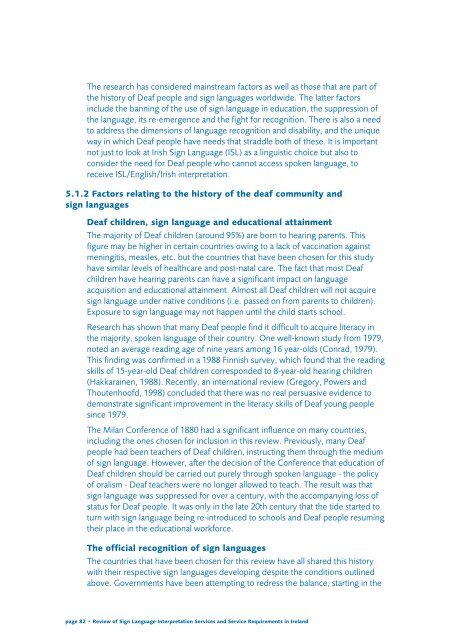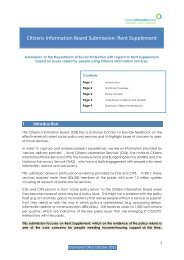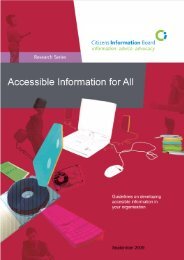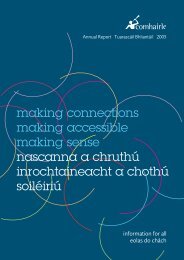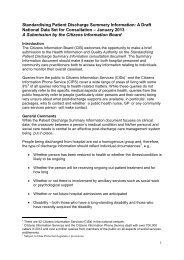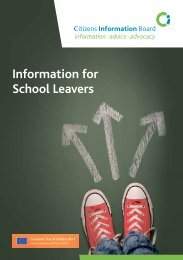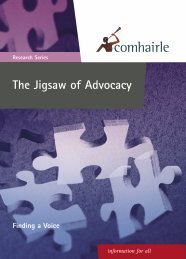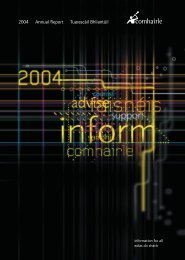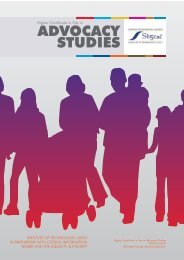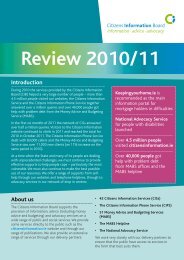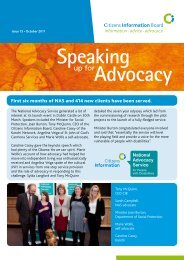Review of Sign Language Interpretation Services and Service ...
Review of Sign Language Interpretation Services and Service ...
Review of Sign Language Interpretation Services and Service ...
- No tags were found...
You also want an ePaper? Increase the reach of your titles
YUMPU automatically turns print PDFs into web optimized ePapers that Google loves.
The research has considered mainstream factors as well as those that are part <strong>of</strong>the history <strong>of</strong> Deaf people <strong>and</strong> sign languages worldwide. The latter factorsinclude the banning <strong>of</strong> the use <strong>of</strong> sign language in education, the suppression <strong>of</strong>the language, its re-emergence <strong>and</strong> the fight for recognition. There is also a needto address the dimensions <strong>of</strong> language recognition <strong>and</strong> disability, <strong>and</strong> the uniqueway in which Deaf people have needs that straddle both <strong>of</strong> these. It is importantnot just to look at Irish <strong>Sign</strong> <strong>Language</strong> (ISL) as a linguistic choice but also toconsider the need for Deaf people who cannot access spoken language, toreceive ISL/English/Irish interpretation.5.1.2 Factors relating to the history <strong>of</strong> the deaf community <strong>and</strong>sign languagesDeaf children, sign language <strong>and</strong> educational attainmentThe majority <strong>of</strong> Deaf children (around 95%) are born to hearing parents. Thisfigure may be higher in certain countries owing to a lack <strong>of</strong> vaccination againstmeningitis, measles, etc. but the countries that have been chosen for this studyhave similar levels <strong>of</strong> healthcare <strong>and</strong> post-natal care. The fact that most Deafchildren have hearing parents can have a significant impact on languageacquisition <strong>and</strong> educational attainment. Almost all Deaf children will not acquiresign language under native conditions (i.e. passed on from parents to children).Exposure to sign language may not happen until the child starts school.Research has shown that many Deaf people find it difficult to acquire literacy inthe majority, spoken language <strong>of</strong> their country. One well-known study from 1979,noted an average reading age <strong>of</strong> nine years among 16 year-olds (Conrad, 1979).This finding was confirmed in a 1988 Finnish survey, which found that the readingskills <strong>of</strong> 15-year-old Deaf children corresponded to 8-year-old hearing children(Hakkarainen, 1988). Recently, an international review (Gregory, Powers <strong>and</strong>Thoutenho<strong>of</strong>d, 1998) concluded that there was no real persuasive evidence todemonstrate significant improvement in the literacy skills <strong>of</strong> Deaf young peoplesince 1979.The Milan Conference <strong>of</strong> 1880 had a significant influence on many countries,including the ones chosen for inclusion in this review. Previously, many Deafpeople had been teachers <strong>of</strong> Deaf children, instructing them through the medium<strong>of</strong> sign language. However, after the decision <strong>of</strong> the Conference that education <strong>of</strong>Deaf children should be carried out purely through spoken language - the policy<strong>of</strong> oralism - Deaf teachers were no longer allowed to teach. The result was thatsign language was suppressed for over a century, with the accompanying loss <strong>of</strong>status for Deaf people. It was only in the late 20th century that the tide started toturn with sign language being re-introduced to schools <strong>and</strong> Deaf people resumingtheir place in the educational workforce.The <strong>of</strong>ficial recognition <strong>of</strong> sign languagesThe countries that have been chosen for this review have all shared this historywith their respective sign languages developing despite the conditions outlinedabove. Governments have been attempting to redress the balance, starting in thepage 82 • <strong>Review</strong> <strong>of</strong> <strong>Sign</strong> <strong>Language</strong> <strong>Interpretation</strong> <strong><strong>Service</strong>s</strong> <strong>and</strong> <strong>Service</strong> Requirements in Irel<strong>and</strong>


